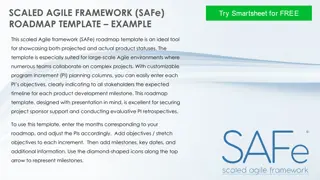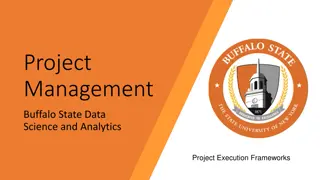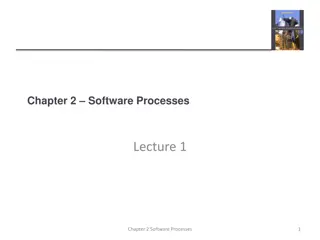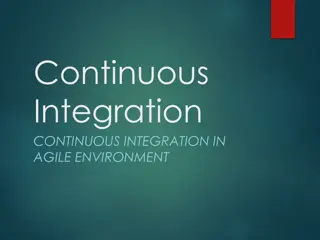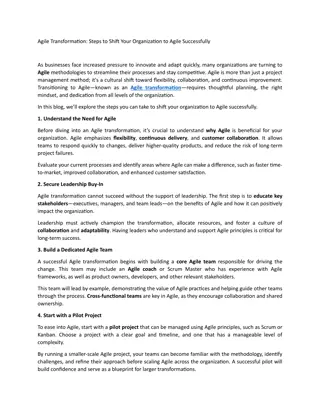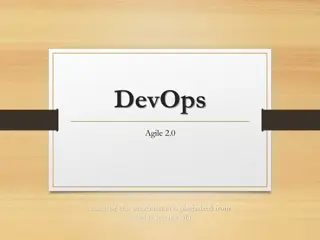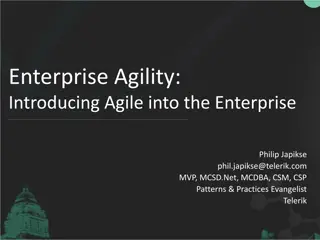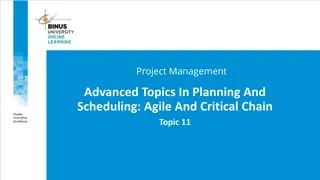Effective AI-Powered Agile Project Management
Agile Project Management focuses on delivering value to customers by reducing project failure risks. However, some tasks like backlog refinement and sprint planning lack sufficient support. This paper introduces an AI-based framework to enhance Agile project management by automating decision-making processes. The proposed components include an Analytics Engine, Planning Engine, Optimization Engine, Conversational Dialog Engine, and Representation Learning Engine.
Download Presentation

Please find below an Image/Link to download the presentation.
The content on the website is provided AS IS for your information and personal use only. It may not be sold, licensed, or shared on other websites without obtaining consent from the author.If you encounter any issues during the download, it is possible that the publisher has removed the file from their server.
You are allowed to download the files provided on this website for personal or commercial use, subject to the condition that they are used lawfully. All files are the property of their respective owners.
The content on the website is provided AS IS for your information and personal use only. It may not be sold, licensed, or shared on other websites without obtaining consent from the author.
E N D
Presentation Transcript
Towards Effective AI- powered Agile Project Management Justice Colby Authors: Hoa Khanh Dam University of Wollongong, Australia Aditya Ghose Unversity of Wollongong Australia Truyen Tran Deakin University, Australia John Grundy Monash University, Australia Yasutaka Kamei Kyushu University, Japan
Introduction Agile Project Management An adaptive PM process which focuses on rapid delivery to customers and reducing the risk of overall project failures. Agile Project Components Product Backlog A collection of items to be completed in the project (requirements, bug fixes, change requests, etc.) Sprints Short periods in which the project team aims to complete a subset of items in the product backlog Sprint Backlog A collection of tasks generated from the product backlog that are to be accomplished in the next sprint
Introduction Estimate Task Breakout Refine Items Sprint Planning
Issues Using the Agile Process, the workloads of Project Managers can be very repetitive and intensive. While existing tools such as Jira and Axosoft are useful, the tasks which they facilitate still require a fair amount of human intervention, and the analytical methods are not as advanced as they could be. Some Agile PM tasks that currently do not have sufficient support include Identifying product backlog items Refining product backlog items Sprint Planning Risk management
AI PM Assistant Authors propose a framework to resolve these issues which includes the following components Analytics Engine Handles Decision-Making during the project. Planning Engine Creates a sprint plan based on provided data and previous project experiences Optimization Engine Assists the Planning Engine by computing the optimal set of actions given the current situation Conversational Dialog Engine Chatbot acting as an interface between users and the AI system Representation Learning Engine Reformats data to be processed by other engines
Representation Learning Engine Creates vector representations for each project component including backlog items, product visions, sprint goals, documentation etc. Input data consists of both structured and unstructured data Consists of three components NLP (Natural Language Processing) component Analyzes textual data Code Modeling component Analyzes Source code Feature Extraction and Aggregation Creates vector representations of developers Both components utilize Long-Term Memory (LSTM) to automatically learn vector representations for both plain text and source code.
Analytics Engine Handles decision making throughout the project Consists of three main components Descriptive Analytics Along with presenting historical data in an intuitive manner, also uses machine learning to discover patterns and identify anomalies to help diagnose why issues have occurred. Predictive Analytics Performs effort estimation and risk prediction using prediction models generated from machine learning. Prescriptive Analytics Uses results from Descriptive Analytics and Predictive Analytics to recommend best course of action to a project team. Useful for identifying/refining backlog items and performing risk mitigation.
Planning & Optimization Engines Planning Engine Uses AI reasoning to take in domain knowledge from the project team and infer new knowledge regarding an ideal sprint plan. Sprint planning can be presented as an AI planning problem Initial state = state of the project and product prior to sprint Goal state = goal of the sprint Choosing backlog items can be viewed as the act of choosing plan operators to be executed from the initial state to the goal state. Optimization Used to compute the optimal selection of backlog items for the upcoming sprint given multiple constraints and objectives Also used for tuning machine learning models used by the analytics engine
Next Steps Authors are developing a protoype of the AI PM assistant They plan to evaluate it using 150 open source projects and to collaborate with industry partners to elaborate some commercial software projects as well.
Thoughts and Limitations The analysis of historical data seems highly beneficial since weekly retrospectives can only go back so far Majority of paper is theoretical as no prototype has been developed. The implementation may be very resource-heavy and difficult to maintain, no information is stated in this regard. The amount of human intervention needed in Agile Project Management may have been underestimated. The authors state that team members can interact with the system, but the types of queries and commands that can be sent are not fully outlined.
Exam Questions Explain three important factors that must be considered when planning a sprint for an agile project. Explain some difficulties/obstacles regarding risk management in an Agile project. What are the necessary considerations when determining the size of sprint backlog items?


